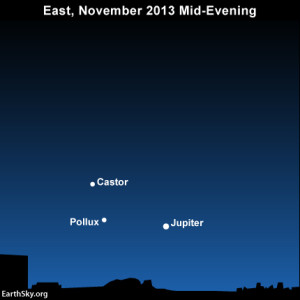EarthSky.org - 11/4/13

Feature chart above: If you trace the South Taurid meteors backward, they all appear to radiate from the constellation Taurus the Bull. But you don’t have to identify Taurus to watch the South Taurid shower.
Look for the thin waxing crescent moon and the dazzling planet Venus in your southwestern sky shortly after sunset.
The planet Jupiter and the Gemini stars, Castor and Pollux, rise above the horizon somewhere around 9 to 10 p.m. local time at mid-northern latitudes.
The constellation Leo the Lion and the red planet Mars rise over the eastern horizon in the wee hours between midnight and dawn.
However, the first thing you want to do after sunset on November 4, 2013, is to catch the waxing crescent moon and the planet Venus low in the west-southwest sky. The moon sets first and Venus sets next, but both are long gone by the time that Taurus fully climbs over the eastern horizon at mid-evening




